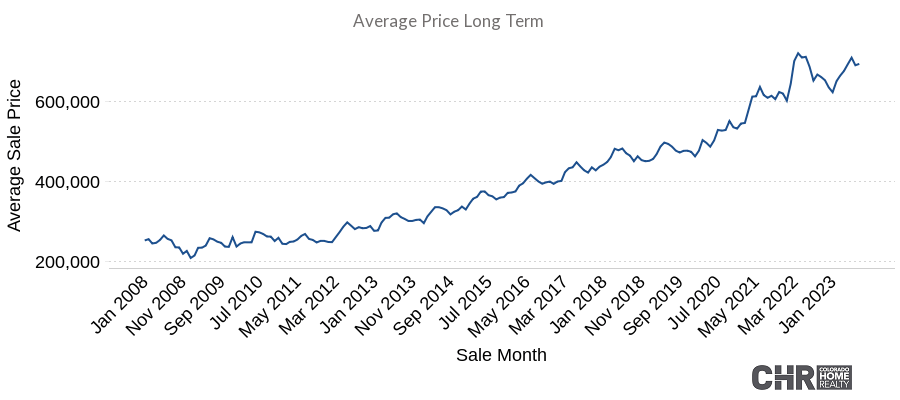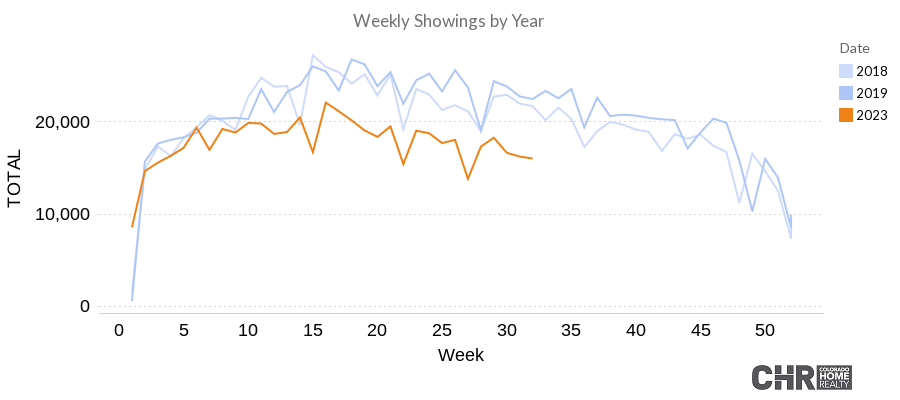What is the Health of Colorado Real Estate?
August 17, 2023 | Market Trends
August 17, 2023 | Market Trends
Over the last 23 years, Colorado real estate has weathered the storms of the original tech bubble, The Great Recession caused by a housing crash and bad lending practices, ten years of robust recovery and wealth building, and the ups and downs of the last three years of the various covid policies, both good and bad.
Through it all, the average home price in the Denver market has increased from a low of $207,606 to a high of $720,137 in April of 2022.

With the rapid rise of interest rates starting in March of 2022, buyer activity shifted, inventory rose, and prices declined through year-end. The market has spent the first half of 2023 slowly recovering from that market adjustment. Prices in the Denver market now surpass 2022 prices by 5.1% or $689,000 versus $655,000 same time last year.

Headlines have suggested catastrophe for real estate, claiming prices are too high relative to interest rates creating a lack of affordability. It is indeed expensive to buy a home in Denver. High-interest rates have also curtailed buyer activity, typically corresponding to lower prices. That is exactly what happened in late spring of 2022.
The headlines, however, only have one half of the equation correct as the other half of the equation is supply, or in the case of real estate, available inventory for sale.
Colorado real estate is exceedingly healthy. Below are the details to explain why and what we predict through year-end and 2024.
Supply is the inventory of homes available to buyers to purchase.
With a rapid rise in interest rates over the last 15 months, buyer activity has declined markedly. If we compare 2023 year-to-date to 2021 and 2022, we might be depressed by a 38% decline in buyer activity.
But we continue to remind our clients that those were two years of unnatural market conditions driven by unsustainable economic policy and social changes. Instead, as we’ve said since late 2022, we expect 2023 and beyond to compare more closely to 2018 and 2019 market conditions.
Buyer activity year to date for 2023 is only 18.2% lower than the 2018 and 2019 average.

If we compare just these three years, 2018, 2019, and 2023, we get a picture that makes more sense. Yes, activity is lower, but it appears seasonally consistent and not catastrophic like headlines would like to push.

Then we look at seller activity. Seller activity has been suppressed for one very simple reason:
The monthly payment cost of a replacement home is much higher than the current mortgage payment for the average homeowner due to the rise in interest rates. Over 70% of all homeowners have an interest rate below 3.5%. It is hard to justify moving to a larger mortgage and/or a much higher payment due to a 7% interest rate.
The result is inventory and seller activity that is even lower than the reduced buyer activity.

Buyer activity is down 18.2% compared to 2018 and 2019. But seller activity is down 29.6%. This means there are relatively more buyers in the market than sellers, once again creating a market dynamic of demand and price appreciation.
Supply and seller behavior will likely remain fairly consistent for years unless interest rates drop (NOTE-If interest rates drop, we will see a surge of buyer activity and even more appreciation).
Sellers now will only move because they NEED TO due to life circumstances such as marriage, divorce, babies, death, and jobs. This will keep the supply/demand ratio in check and most likely result in continued home value appreciation.
So is the Colorado real estate market healthy? Yes.
In 2024, we anticipate low inventory, modest buyer activity, and continued home value appreciation.
In addition to the simple supply/demand equation, we look at a few other ingredients to market conditions that support the conclusion of ongoing home value appreciation in Colorado.
Population Increase-It is anticipated by 2050 that the population of the I-25 corridor, from Pueblo to Fort Collins, will more than double. While Denver isn’t considered as sexy of a city as it was just 5 years ago, Colorado is a highly sought-after place to live. The immigration from all parts of the country to Colorado is profound. This means more demand.
Housing Supply Relative to Population-20 years ago, the population of Colorado was approximately 4.3 million people. At that time, there were approximately 20,000 homes available for sale in Denver. And the market was experiencing a 3-5% appreciation rate each year.
Colorado’s population today is approximately 6 million people, and the available homes for sale in the Denver market are approximately 6,500. By 2040, or just 17 years from now, Colorado’s population is anticipated to be 7.7 million people.
The Colorado supply/demand equation is not changing soon; as a result, we will see continued home value appreciation.
Are there macroeconomic and geopolitical factors that could imbalance these projections, weaken the Colorado economy, and harm buyers’ ability to purchase? Yup. But these forces are always at play and always a possibility. We don’t want to be obtuse about their possibility. Still, we also must acknowledge the current conditions supporting the conclusion that Colorado real estate remains one of the best and most secure financial decisions available.
Share this Post